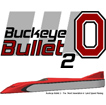By Joan Slattery Wall
Somnath Ghosh envisions a day when the lifespan of aircraft engines could be predicted with better certainty.
The variables involved, however, seem endless: How much load would the aircraft carry? What are the failure characteristics of each composite used in each part? How much impact could they withstand? What effect does natural degradation have over time?
“I use computational mechanics and materials modeling to make those predictions so we can bypass the need for very expensive and sometimes impossible experiments,” says Ghosh, professor of mechanical engineering and materials science and engineering. “Our computational simulations are like virtual experiments to simulate the real behavior and to incorporate the findings into design.”
He would not be able to conduct such complex research without the aid of high-performance computing facilities, but he doesn’t have to go far to find such resources. The Ohio Supercomputer Center, on Ohio State’s West Campus, allows him to examine and predict reliability from the very small scale of the materials used in parts all the way up to the overall structure. For example, he has examined aerospace systems for the Air Force, thermal barrier coatings such as those on space shuttles for NASA, aluminum sheeting for ALCOA, aluminum castings for Ford and nanocomposites for drug delivery systems. Just one example of results: His findings of better systems of aluminum rolling resulted in approximately $150 million in annual energy savings for ALCOA.
Hundreds of Ohio researchers, many of whom, like Ghosh, are Ohio State faculty, take advantage of the Ohio Supercomputer Center, which has its 20th anniversary this year.
“This is a statewide resource available for the higher education community and the industrial community to do complex calculations to advance science, economic development and the development of products,” says center director Stanley Ahalt, an Ohio State professor of electrical and computer engineering.
The center also is a resource for engineering students. Kimberly Stevens, a senior majoring in aeronautical and astronautical engineering, used software there to simulate the shape of the Buckeye Bullet 2, a high-performance hydrogen fuel-cell powered race car. Using computational fluid dynamics, Stevens modeled real-world aerodynamics, and the Buckeye Bullet team built a model for testing in a Penske wind tunnel.
“We went to the wind tunnel in North Carolina with a really good shape and good idea of what to expect from the wind tunnel testing,” Stevens says. “Since the car was already optimized for drag, we were able to focus on stability issues.”
She also plans to use the software to help design the cooling system of the car. In fact, Stevens enjoys computational fluid dynamics so much that she intends to make a career of it.
“The experience offered by the Ohio Supercomputer Center has lead to two really cool jobs for me: a computational fluid dynamics co-op position with Honda Research and Development and a computational fluid dynamics research job for the Department of Aerospace Engineering here at Ohio State,” she says, noting that she’ll start a master’s degree in 2008.
Early this year, the state granted the center more than $4.4 million for an upgrade to be completed this summer. Ashok Krishnamurthy, Ohio Supercomputer Center director of research and an associate professor of electrical and computer engineering, says faculty and students across the state can access the center’s systems and network, and researchers there can assist them. Some other examples of how campus researchers use the center:
Joel Saltz, chair of biomedical informatics at the College of Medicine, is creating an infrastructure for cancer research to enable data sharing, and Hamish Fraser, professor of materials science and engineering, is working with the center to develop a system that could provide remote control and use of powerful microscopes in the department. With the medical school, researchers at the center are evaluating the effectiveness of a virtual trainer with haptic, or sense of touch, feedback, and they have developed technology to virtually train tanker truck drives.
Even though Ahalt has directed the center’s day-to-day operations since 2003 — “This kind of a job is all-consuming,” he says — he still seems in awe of the capabilities of the Ohio Supercomputer Center, where key areas of research, in addition to high-performance computing and networking, include homeland security and defense, environmental sciences and life sciences.
He even remembers when it was built, in 1987 — the year he was hired at Ohio State as an assistant professor.
“I sat out in the field when they started digging for the Ohio Supercomputer Center,” he says. “I thought it was the coolest thing.”
Editor’s note: This story is reprinted with permission from News In Engineering, the magazine for The Ohio State University College of Engineering. (http://www.eng.ohio-state.edu/)
